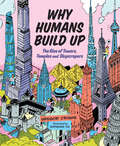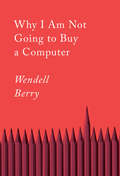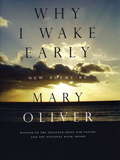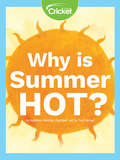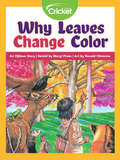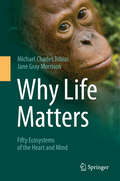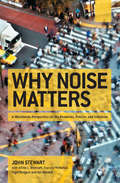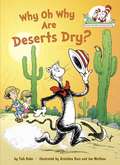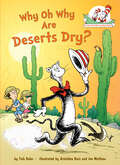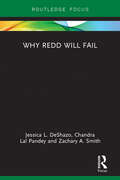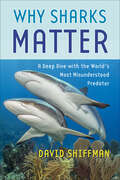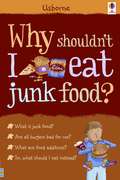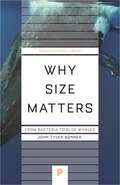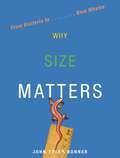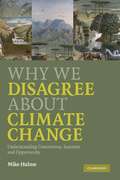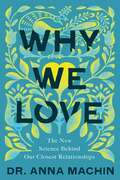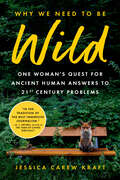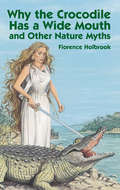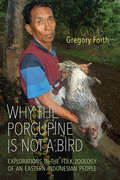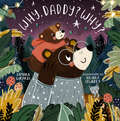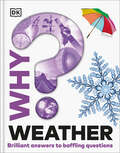- Table View
- List View
Why Greenland Is an Island, Australia Is Not, and Japan Is Up for Grabs
by Joyce DavisFrom the book: Any geographer will tell you that a map is but one of many tools used in the field, yet every geography book on the market tries to teach geography simply by having you identify Belize on a map or memorize the capital of Idaho. While the where is important, it is useful only for trivial reasons, and once national boundaries change or disappear, such as we've recently seen in the former Yugoslavia, the information is all but useless. In Why Greenland Is an Island, Australia Is Not-and Japan Is Up for Grabs, Joyce Davis tells you the why behind the where, offering one of the most interesting and useful books on geography currently found on the market. In Why Greenland Is an Island you will discover a clear method of approaching any geographical dilemma you might face. Through six simple steps Joyce Davis shows not only how to gather geographical information about any region, but also how to understand other aspects of the region seemingly not related to geography. You will also gain a solid background in basic geography skills, and will even touch base on what the capital of Idaho is and learn how to read a map. If you're tired of geography books that leave you feeling more helpless than when you first opened them, then it's time to get your bearings and read Joyce Davis's Why Greenland Is an Island now. Joyce Davis is a teacher of geography and former head of the history and geography departments at the Grace Church School in New York City. An originator of the geographic curriculum there and founder of the school's annual "geography bee," she currently lives 74 degrees west longitude and 40.5 degrees north latitude, also known as New York City.
Why Humans Build Up: The Rise of Towers, Temples and Skyscrapers (Orca Timeline #1)
by Gregor Craigie★“This great STEAM offering has multiple applications and will be useful for report writers and aspiring architects alike.”—Booklist, starred review ★“Finely detailed inside and outside...Broad in scope, perceptively organized, and enriched with fascinating entries.”—Kirkus Reviews, starred review Why did they build it so high? People have been constructing tall buildings for thousands of years, for many different reasons. Castle walls kept people safe. Utility towers transmit TV and cell-phone signals. Observatories give people a bird’s-eye view of the world. Beautiful buildings stand out in the crowd. Skyscrapers provide housing for a lot of people. There are some good reasons for building up, and a few bad ones as well. With a growing global population, we will need more and more space to live, learn and work in. But what does that mean for the health of the planet? Can we do it sustainably? Tall buildings may be part of the answer. From the Great Pyramids of Giza and the Leaning Tower of Pisa to the Burj Khalifa and the Shanghai Tower, Why Humans Build Up asks why and how we build higher and higher, and what that means for the planet.
Why I Am Not Going to Buy a Computer: Essays (Counterpoints #6)
by Wendell BerryA brief meditation on the role of technology in his own life and how it has changed the landscape of the United States from "America's greatest philosopher on sustainable life and living" (Chicago Tribune)."A number of people, by now, have told me that I could greatly improve things by buying a computer. My answer is that I am not going to do it. I have several reasons, and they are good ones."Wendell Berry first challenged the idea that our advanced technological age is a good thing when he penned "Why I Am Not Going to Buy a Computer" in the late 1980s for Harper's Magazine, galvanizing a critical reaction eclipsing any the magazine had seen before. He followed by responding with "Feminism, the Body, and the Machine." Both essays are collected in one short volume for the first time.
Why I Wake Early
by Mary OliverThe forty-seven new works in this volume include poems on crickets, toads, trout lilies, black snakes, goldenrod, bears, greeting the morning, watching the deer, and, finally, lingering in happiness. Each poem is imbued with the extraordinary perceptions of a poet who considers the everyday in our lives and the natural world around us and finds a multitude of reasons to wake early.
Why Is Summer Hot?
by Kathleen Weidner ZoehfeldHave you ever wondered why the days are so long in the summer and short in the winter? Or why we have hot weather and colder weather? Read on to learn about how the Earth, how it spins around the Sun, and the seasons!
Why Leaves Change Color: An Ojibwe Story
by Margi PreusNanabozho—part man, part spirit—is an Ojibwe trickster character, capable of great mischief. Nanabozho teaches us that beauty can sometimes come from mischief. In this story, Nanabozho "paints" the animal kingdom, giving color to each creature he can find.
Why Life Matters
by Michael Charles Tobias Jane Gray MorrisonDr. Michael Charles Tobias and Jane Gray Morrison are world-renowned ecological philosophers and activists, interdisciplinary social and environmental scientists and broad-ranging, deeply committed humanists. This collection of fifty essays and interviews comprises an invigorating, outspoken, provocative and eloquent overview of the ecological humanities in one highly accessible volume. The components of this collection were published in the authors' "Green Conversations" blog series, and pieces in the Eco News Network from 2011 to 2013 and feature luminaries from Jane Goodall to Ted Turner to the Secretary of the Smithsonian Institution to the former head of the UN Convention on Biological Diversity. Stunning color photographs captured by the authors and contributors make Why Life Matters: Fifty Ecosystems of the Heart and Mind a feast for the eyes as well as the mind and soul. Ethics, science, technology, ecological literacy, grass-roots renaissance thinkers, conservation innovation from the U. S. to the U. K. ; from India to Ecuador; from Bhutan to Haiti; from across Africa, the Neo-Tropics, Central Asia and Japan, to Rio, Shanghai and Manhattan - this humanistic ode to the future of life on earth is a relevant and resonating read. Michael Tobias and Jane Gray Morrison, partners who between them have authored some 50 books and written, directed and produced some 170 films, a prolific body of work that has been read, translated and/or broadcast around the world, have been married for more than a quarter-of-a-century. Their field research across the disciplines of comparative literature, anthropology, the history of science and philosophy, ecology and ethics, in over 80 countries, has served as a telling example of what two people - deeply in love with one another - can accomplish in spreading that same unconditional love to others - of all species.
Why Noise Matters: A Worldwide Perspective on the Problems, Policies and Solutions
by John Stewart Nigel Rodgers Francis McManus Val Weedon Arline BronzaftIs noise the most neglected green issue of our age? This book argues compellingly that it is, and tells you all you need to know about noise as a social, cultural, environmental and health issue. Across the world, more people are disturbed by noise in their day-today lives than by any other pollutant on Earth. From the shanty towns of Mumbai to the smart boulevards of Paris, noise is a problem. It is damaging people's health, costing billions, and threatening the world's natural sound systems in the same way that climate change is altering its eco-systems. Drawing on evidence from all over the world, this book showcases policies and strategies that have worked to decrease noise pollution, and offers lessons for policymakers and environmental health professionals, campaigners and any individual affected by noise. Written by a renowned noise campaigner and experts in law and health, this book tells you all you need to know about noise as a social, cultural and environmental issue and how we can act to build a more peaceful world.
Why Not Jail?
by Rena SteinzorThe U.S. Department of Justice is under fire for failing to prosecute banks that caused the 2008 economic meltdown because they are too big to jail. Prosecutors have long neglected to hold corporate executives accountable for chronic mistakes that kill and injure workers and customers. This book, the first of its kind, analyzes five industrial catastrophes that have killed or sickened consumers and workers or caused irrevocable harm to the environment. From the Texas City refinery explosion to the Upper Big Branch mine collapse to the destruction of the Deepwater Horizon oil rig and extending to incidents of food and drug contamination that have killed or injured hundreds, the root causes of these preventable disasters include crimes of commission and omission. Although federal prosecutors have made a start on holding low-level managers liable, far more aggressive prosecution is appropriate as a matter of law, policy, and justice. Written in accessible and jargon-free language, this book recommends innovative interpretations of existing laws to elevate the prosecution of white-collar crime at the federal and state levels.
Why Oh Why Are Deserts Dry? All About Deserts
by Joe Mathieu Aristides Ruiz Tish RabeIn this latest installation of the Cat in the Hat's Learning Library, the Cat takes Sally and Dick to explore different kinds of deserts around the world, from the hot, dry Sonoran and Mojavi to the bitter cold Gobi and Antarctica. Young readers learn why deserts are dry, and how plants and animals--including cactus, kangaroos, camels, penguins, roadrunners, and many others--have adapted to survive the unforgiving climate. Also included: how sand dunes are formed; the reason we see mirages, and how shallow water beneath the surface of the ground can create an oasis. Fans of the new PBS preschool science show The Cat in the Hat Knows a Lot About That! (which is based on the Learning Library series) won't want to miss this hot new addition to the series!
Why Oh Why Are Deserts Dry? All About Deserts: All About Deserts (The Cat in the Hat's Learning Library)
by Tish RabeLaugh and learn with fun facts about desert animals, cacti, sand dunes, and more—all told in Dr. Seuss&’s beloved rhyming style and starring the Cat in the Hat! &“You may think that deserts are empty and bare, but you&’ll be surprised by the things we&’ll find there...&” The Cat in the Hat&’s Learning Library series combines beloved characters, engaging rhymes, and Seussian illustrations to introduce children to non-fiction topics from the real world! Journey through the deserts of the world and learn: how plants and animals have adapted to survive the unforgiving climatewhy deserts don&’t have to be hotwhat causes us to see miragesand much more! Perfect for story time and for the youngest readers, Why Oh Why Are Deserts Dry? All About Deserts also includes an index, glossary, and suggestions for further learning.Look for more books in the Cat in the Hat&’s Learning Library series!Cows Can Moo! Can You? All About FarmsHark! A Shark! All About SharksIf I Ran the Dog Show: All About DogsOh Say Can You Say Di-no-saur? All About DinosaursOn Beyond Bugs! All About InsectsOne Vote Two Votes I Vote You VoteThere&’s No Place Like Space: All About Our Solar SystemWho Hatches the Egg? All About EggsWish for a Fish: All About Sea Creatures
Why REDD will Fail (Routledge Studies in Environmental Policy)
by Zachary A. Smith Chandra Lal Pandey Jessica L. DeShazoReducing Emissions from Deforestation and forest Degradation (REDD) attempts to address climate change from one angle – by paying developing countries to slow or stop deforestation and forest degradation. Trumpeted as a way to both mitigate climate change and assist countries with development, REDD was presented as a win-win solution. However, there have been few attempts to understand and analyse the overall framework. Why REDD Will Fail argues that the important goals will not be met under the existing REDD regime unless the actual drivers of deforestation and forest degradation are diminished. The book delves into the problematic details of the regime, ranging from; national capacity to monitor results, the funding mechanism, the definition of a forest, leakage, and the impetus behind the drivers of deforestation and forest degradation. As the international community rallies around REDD and developed countries and companies are willing to commit substantial amounts to implement the scheme, this books seeks to address whether REDD has the potential to achieve its purported goals. This is an important resource for academics and students interested in the policy and management aspects of mitigating climate change, environmental policy, international relations and development studies as well as policy makers involved in the REDD process.
Why Sharks Matter: A Deep Dive with the World's Most Misunderstood Predator
by David ShiffmanGet submerged in the amazing world of sharks! Your expert host, award-winning marine biologist Dr. David Shiffman, will show you how—and why—we should protect these mysterious, misunderstood guardians of the ocean.Sharks are some of the most fascinating, most ecologically important, most threatened, and most misunderstood animals on Earth. More often feared than revered, their role as predators of the deep have earned them a reputation as a major threat to humans. But the truth is that sharks are not a danger to us—they're in danger from us.In Why Sharks Matter, marine conservation biologist Dr. David Shiffman explains why it's crucial that we overcome our misconceptions and rise above cinematic jump scares to embrace sharks as the imperiled and elegant ocean guardians they really are. Sharing his own fascinating experiences working with sharks, Shiffman tells us• why healthy shark populations are a must for supporting ocean ecosystems—and the coastal economies that depend on them • why we're in danger of losing many shark species forever• what scientists, conservationists, and readers can do to help save these iconic predators• why so much of what you've heard about sharks and how to save them is wrong Exploring the core tenets of shark conservation science and policy, Shiffman synthesizes decades of scientific research and policymaking, weaving it into a narrative full of humor and adventure. Touching on everything from Shark Week to shark fin soup, overfishing to marine sanctuaries, Shiffman reveals why sharks are in trouble, why we should care, and how we can save them. Perfect for shark enthusiasts, Why Sharks Matter is an approachable, informative guide to the world of shark conservation and the passionate, fascinating, brilliant people who work to understand and protect our oceans. This fun read will have you looking at sharks with a fresh perspective and an understanding that the survival of sharks is crucial to the survival of another apex predator—ourselves.
Why Shouldn't I Eat Junk Food?
by Adam Larkum Kate Knighton Nancy LeschnikoffThis is an informative guide to two of the hottest debates surrounding children today: Junk food and healthy eating. Written in a conversational style, this book offers children an approachable source of information on key subjects such as food labelling, the effects of eating too much junk food, the importance of a varied diet and how food is grown. It is accompanied by the witty and vibrant illustrations of Adam Larkum. It is written in conjunction with child nutrition experts.
Why Size Matters: From Bacteria to Blue Whales (Princeton Science Library #142)
by John Tyler BonnerJohn Tyler Bonner, one of our most distinguished and creative biologists, here offers a completely new perspective on the role of size in biology. In his hallmark friendly style, he explores the universal impact of being the right size. By examining stories ranging from Alice in Wonderland to Gulliver's Travels, he shows that humans have always been fascinated by things big and small. Why then does size always reside on the fringes of science and never on the center stage? Why do biologists and others ponder size only when studying something else—running speed, life span, or metabolism?Why Size Matters, a pioneering book of big ideas in a compact size, gives size its due by presenting a profound yet lucid overview of what we know about its role in the living world. Bonner argues that size really does matter—that it is the supreme and universal determinant of what any organism can be and do. For example, because tiny creatures are subject primarily to forces of cohesion and larger beasts to gravity, a fly can easily walk up a wall, something we humans cannot even begin to imagine doing.Bonner introduces us to size through the giants and dwarfs of human, animal, and plant history and then explores questions including the physics of size as it affects biology, the evolution of size over geological time, and the role of size in the function and longevity of living things.As this elegantly written book shows, size affects life in its every aspect. It is a universal frame from which nothing escapes.
Why Size Matters: From Bacteria to Blue Whales (Princeton Science Library #142)
by John Tyler BonnerWhy size plays such a big role in the living worldJohn Tyler Bonner, one of our most distinguished and creative biologists, here offers a completely new perspective on the role of size in biology. In his hallmark friendly style, he explores the universal impact of being the right size. By examining stories ranging from Alice in Wonderland to Gulliver's Travels, he shows that humans have always been fascinated by things big and small. Why then does size always reside on the fringes of science and never on the center stage? Why do biologists and others ponder size only when studying something else--running speed, life span, or metabolism?Why Size Matters, a pioneering book of big ideas in a compact size, gives size its due by presenting a profound yet lucid overview of what we know about its role in the living world. Bonner argues that size really does matter--that it is the supreme and universal determinant of what any organism can be and do. For example, because tiny creatures are subject primarily to forces of cohesion and larger beasts to gravity, a fly can easily walk up a wall, something we humans cannot even begin to imagine doing.Bonner introduces us to size through the giants and dwarfs of human, animal, and plant history and then explores questions including the physics of size as it affects biology, the evolution of size over geological time, and the role of size in the function and longevity of living things.As this elegantly written book shows, size affects life in its every aspect. It is a universal frame from which nothing escapes.
Why We Disagree About Climate Change
by Mike HulmeClimate change is not 'a problem' waiting for 'a solution'. It is an environmental, cultural and political phenomenon which is re-shaping the way we think about ourselves, our societies and humanity's place on Earth. Drawing upon twenty-five years of professional work as an international climate change scientist and public commentator, Mike Hulme provides a unique insider's account of the emergence of this phenomenon and the diverse ways in which it is understood. He uses different standpoints from science, economics, faith, psychology, communication, sociology, politics and development to explain why we disagree about climate change. In this way he shows that climate change, far from being simply an 'issue' or a 'threat', can act as a catalyst to revise our perception of our place in the world. Why We Disagree About Climate Change is an important contribution to the ongoing debate over climate change and its likely impact on our lives.
Why We Disagree about Climate Change: Understanding Controversy, Inaction and Opportunity
by Mike HulmeClimate change is not 'a problem' waiting for 'a solution'. It is an environmental, cultural and political phenomenon which is re-shaping the way we think about ourselves, our societies and humanity's place on Earth. Drawing upon twenty-five years of professional work as an international climate change scientist and public commentator, Mike Hulme provides a unique insider's account of the emergence of this phenomenon and the diverse ways in which it is understood. He uses different standpoints from science, economics, faith, psychology, communication, sociology, politics and development to explain why we disagree about climate change. In this way he shows that climate change, far from being simply an 'issue' or a 'threat', can act as a catalyst to revise our perception of our place in the world. Why We Disagree About Climate Change is an important contribution to the ongoing debate over climate change and its likely impact on our lives.
Why We Hate the Oil Companies: Straight Talk from an Energy Insider
by John HofmeisterAs president of Shell Oil, John Hofmeister was known for being a straight shooter, willing to challenge his peers throughout the industry. Now, he's a man on a mission, the founder of Citizens for Affordable Energy, crisscrossing the country in a grassroots campaign to change the way we look at energy in this country. While pundits proffer false new promises of green energy independence, or flatly deny the existence of a problem, Hofmeister offers an insider's view of what's behind the energy companies' posturing, and how politicians use energy misinformation, disinformation, and lack of information to get and stay elected. He tackles the energy controversy head-on, without regard for political correctness. He also provides a new framework for solving difficult problems, identifying solutions that will lead to a future of comfortable lifestyles, affordable and clean energy, environmental protection, and sustained economic competitiveness.
Why We Love: The New Science Behind Our Closest Relationships
by Dr. Anna MachinAn Oxford evolutionary anthropoloigst explores the ever-elusive science of love.
Why We Need to Be Wild: One Woman's Quest for Ancient Human Answers to 21st Century Problems
by Jessica Carew Kraft"In the tradition of the best immersive journalism." –A.J. Jacobs, author of The Year of Living BiblicallyA bold examination of how Paleolithic wisdom could solve our 21st century problemsJessica Carew Kraft, an urban wife and mom of two, was firmly rooted in the modern world, complete with a high-powered career in tech and the sneaking suspicion that her lifestyle was preventing her and her family from truly thriving. Determined to find a better way, Jessica quit her job and set out to learn about "rewilding" from people who reject the comforts and convenience of civilization by using ancient tools and skills to survive. Along the way, she learned how to turn sticks into fire, stones into axes, and bones into tools for harvesting wild food—and found an entire community walking the path back from our technology-focused, anxiety-ridden way of life to a simpler, more human experience.Weaving deep research and reportage with her own personal journey, Jessica tells the remarkable story of the potential benefits rewilding has for us and our planet, and questions what it truly means to be a human in today's world. For readers of A Hunter-Gatherer's Guide to the 21st Century and Hunt, Gather, Parent, Why We Need to Be Wild is a thought-provoking, unforgettable narrative that illuminates how we survived in the past, how we live now, and how each of us can choose to thrive in the years ahead. "Kraft shows us how we could all benefit from being a little less civilized." —Tiffany Shlain, author of 24/6: The Power of Unplugging One Day a Week
Why the Crocodile Has a Wide Mouth: and Other Nature Myths (The Land of Oz)
by Florence HolbrookThese fifty-four wonder-filled stories, adapted for curious young minds, describe in simple folktale style how many amazing creatures of the earth were created — and why they look and act as they do — and other natural phenomena.Learn why the rabbit is timid and the bear has a short tail. Find out how fire was brought to the Indians, and how summer came to the earth. Discover why the sea is salty and evergreen trees never lose their leaves. Meet the children in the moon and the first grasshopper.Enhanced by 29 illustrations, these beguiling narratives gathered from primitive cultures around the world will delight children, lovers of tall tales, and anyone interested in folklore from faraway lands.
Why the Porcupine is Not a Bird: Explorations in the Folk Zoology of an Eastern Indonesian People
by Gregory ForthWhy the Porcupine Is Not a Bird is a comprehensive analysis of knowledge of animals among the Nage people of central Flores in Indonesia. Gregory Forth sheds light on the ongoing anthropological debate surrounding the categorization of animals in small-scale non-Western societies.Forth's detailed discussion of how the Nage people conceptualize their relationship to the animal world covers the naming and classification of animals, their symbolic and practical use, and the ecology of central Flores and its change over the years. His study reveals the empirical basis of Nage classifications, which align surprisingly well with the taxonomies of modern biologists. It also shows how the Nage employ systems of symbolic and utilitarian classification distinct from their general taxonomy. A tremendous source of ethnographic detail, Why the Porcupine Is Not a Bird is an important contribution to the fields of ethnobiology and cognitive anthropology.
Why, Daddy? Why?
by Tamara GirardiBaby bear's favorite word is 'Why?' but daddy bear always responds with love and patience. The perfect book for new dads!
Why? Weather: Brilliant Answers to Baffling Questions (Why? Series)
by DKExplore the intriguing answers to more than 200 questions about weather and learn all about the real-time impacts of the climate crisis in this absorbing encyclopedia for kids.What happens inside a thundercloud? Why is the sky not always blue? How are hurricanes born? Why is climate change dangerous? This children's book helps inquisitive minds find out answers to all the questions they may have about weather and climate, and some they hadn't thought of! Featuring detailed explanations to weather wonders, extreme weather, the science of weather forecasting, and climate change, Why? Weather helps children become weather experts in no time. Each page asks and answers a different question, and features a quick quiz designed to cement new knowledge. Bursting with mind-boggling facts, stunning photography, and extensive diagrams, this visually appealing book will be treasured by every budding meteorologist.

